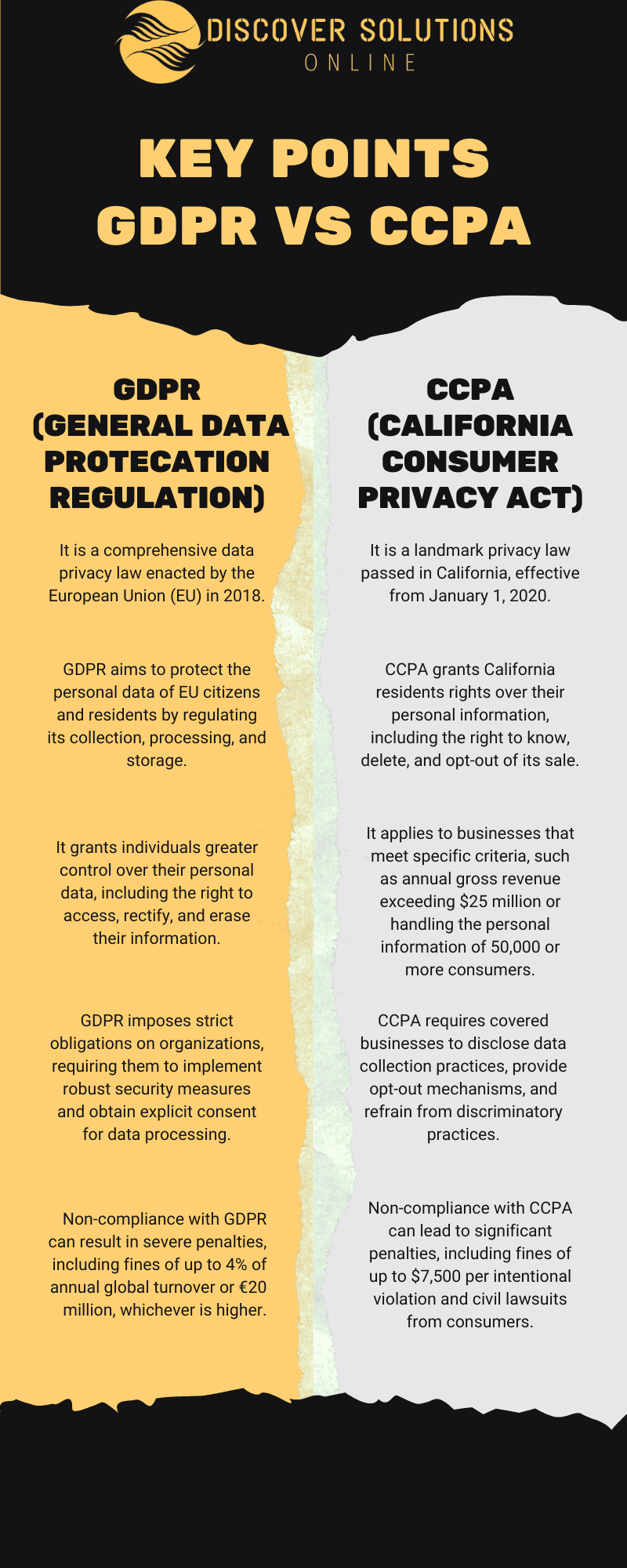In the digital age, where data flows ceaselessly, ensuring compliance with privacy regulations has become paramount. Among the foremost concerns for businesses are the General Data Protection Regulation (GDPR) in the European Union and the California Consumer Privacy Act (CCPA) in the United States. These regulations mandate stringent measures to protect individuals’ data privacy rights, including redaction strategies to safeguard sensitive information. Understanding the redaction requirements under GDPR and CCPA is crucial for businesses to navigate the complex landscape of data privacy compliance effectively.
Redaction Requirements Under GDPR
The GDPR, implemented in May 2018, revolutionized data protection laws, empowering individuals with greater control over their personal data. Key redaction requirements under the GDPR include:
Principle of Lawfulness, Fairness, and Transparency: Article 5 of the GDPR mandates that personal data shall be processed lawfully, fairly, and transparently. Redaction plays a crucial role in upholding these principles by ensuring that only necessary and relevant information is retained, while sensitive details are appropriately obscured.
Data Minimization
GDPR emphasizes data minimization, advocating for the collection and processing of only the minimum amount of personal data necessary for a specific purpose. Redaction enables organizations to adhere to this principle by selectively removing extraneous or irrelevant information from documents or datasets.
Right to Erasure (Right to Be Forgotten)
Under Article 17 of the GDPR, individuals have the right to request the deletion or removal of personal data when there is no compelling reason for its continued processing. Redaction facilitates compliance with this provision by securely removing identifiable information from records or databases in response to such requests.
Pseudonymization and Anonymization
GDPR encourages the use of pseudonymization and anonymization techniques to protect individuals’ privacy. While pseudonymization involves replacing identifying information with pseudonyms or codes, anonymization irreversibly transforms data so that individuals cannot be identified. Redaction may be employed as part of these techniques to obscure direct identifiers before further processing or analysis.
Data Security and Integrity
GDPR mandates appropriate security measures to protect personal data against unauthorized access, disclosure, or alteration. Redaction contributes to data security by reducing the risk of inadvertent disclosure of sensitive information, thereby safeguarding the integrity and confidentiality of personal data.
Redaction Requirements Under CCPA
The CCPA, effective from January 2020, introduced comprehensive privacy rights for California residents and imposed obligations on businesses handling their personal information. Key redaction requirements under the CCPA include:
Right to Know and Right to Deletion
CCPA grants consumers the right to know what personal information is collected, disclosed, or sold about them, as well as the right to request the deletion of their personal information held by businesses. Redaction facilitates compliance with these rights by selectively removing or obscuring identifiable information in response to consumer requests.
Sensitive Personal Information (SPI) Categories
CCPA identifies specific categories of sensitive personal information, such as social security numbers, financial account information, and precise geolocation data, requiring businesses to exercise heightened protection measures. Redaction helps mitigate the risk of unauthorized access or disclosure of SPI by masking or eliminating such sensitive details from documents or datasets.
Data Security Obligations
CCPA imposes obligations on businesses to implement reasonable security measures to safeguard consumers’ personal information against unauthorized access, disclosure, or destruction. Redaction serves as a critical security measure by minimizing the exposure of sensitive information, thereby reducing the risk of data breaches or unauthorized disclosures.
Non-Discrimination Principle
CCPA prohibits businesses from discriminating against consumers who exercise their privacy rights, such as the right to opt-out of the sale of personal information. Redaction ensures equal treatment by preserving the confidentiality of consumers’ data while honoring their privacy preferences and choices.
Third-Party Disclosures
CCPA requires businesses to disclose whether they sell consumers’ personal information to third parties and provide consumers with the option to opt-out of such sales. Redaction may be utilized to redact or anonymize personal information before sharing it with third parties, ensuring compliance with disclosure requirements while protecting individuals’ privacy.

Best Practices for Redaction Compliance
To effectively comply with redaction requirements under GDPR and CCPA, businesses should adopt the following best practices:
Develop Redaction Policies and Procedures
Establish comprehensive redaction policies and procedures outlining the criteria for identifying and redacting sensitive information, the methods and tools to be used, and the roles and responsibilities of personnel involved in the redaction process.
Regularly Review and Update Redaction Practices
Conduct periodic reviews of redaction practices to ensure alignment with evolving regulatory requirements, technological advancements, and organizational changes. Update redaction policies and procedures accordingly to mitigate compliance risks effectively.
Provide Training and Awareness Programs
Educate employees about the importance of redaction compliance, the risks associated with mishandling sensitive information, and the proper procedures for redacting personal data. Offer training sessions and awareness programs to enhance employees’ understanding of their roles and responsibilities in safeguarding data privacy.
Engage Legal and Compliance Experts
Collaborate with legal and compliance experts to interpret and apply relevant provisions of GDPR, CCPA, and other applicable privacy regulations. Seek expert guidance in addressing complex redaction scenarios, interpreting data subject requests, and ensuring compliance with regulatory requirements.
Challenges of Redacting Personally Identifiable Information (PII)
Data privacy compliance has become a paramount concern for organizations worldwide, particularly with the advent of regulations like the General Data Protection Regulation (GDPR) and the California Consumer Privacy Act (CCPA). Among the myriad tasks involved in compliance, redacting Personally Identifiable Information (PII) presents significant challenges. In this segment, we delve into the complexities and hurdles faced by organizations when implementing redaction strategies to safeguard PII under GDPR and CCPA.
Understanding Redaction
Before delving into the challenges, it’s crucial to grasp the concept of redaction. Redaction involves the removal or masking of sensitive information from documents or datasets to prevent unauthorized access or disclosure. While seemingly straightforward, the execution of redaction strategies poses numerous hurdles, especially concerning the identification and handling of PII.
Data privacy has emerged as a critical concern for individuals and organizations alike. With the advent of regulations such as the General Data Protection Regulation (GDPR) and the California Consumer Privacy Act (CCPA), the protection of personally identifiable information (PII) has become a legal imperative.
Redacting PII—removing or masking sensitive data to protect privacy—plays a pivotal role in compliance efforts. However, the process of redaction is fraught with challenges, ranging from identifying PII to balancing accuracy and efficiency. In this comprehensive exploration, we delve into the multifaceted challenges organizations face when redacting PII to comply with GDPR and CCPA requirements.
Identifying the Scope of PII
At the core of any redaction strategy lies the challenge of accurately identifying the scope of PII within vast datasets or documents. PII encompasses a wide range of information, including names, addresses, social security numbers, email addresses, phone numbers, financial data, biometric identifiers, and more. However, the complexity arises from the sheer volume and diversity of data formats in which PII can exist.
In today’s data-driven landscape, organizations accumulate vast amounts of data from various sources, including customer interactions, transactions, and third-party vendors. As data proliferates across disparate systems and platforms, identifying all instances of PII becomes a Herculean task. Moreover, the dynamic nature of PII compounds the challenge, as individuals update their information over time, leading to constant changes in the data landscape.
To address this challenge, organizations must deploy advanced technologies such as machine learning and natural language processing (NLP) to automate the identification of PII. By leveraging these technologies, organizations can analyze large volumes of data more efficiently and accurately, thereby reducing the risk of overlooking sensitive information.
Data Fragmentation and Contextual Understanding
In addition to the sheer volume of data, PII is often fragmented across multiple sources and presented in diverse contexts. For example, an individual’s name may appear alongside their contact information in one document and alongside transactional data in another.
Redaction tools must possess advanced contextual understanding capabilities to accurately identify and redact PII in such scenarios.
Achieving contextual understanding involves more than just recognizing keywords or patterns; it requires an understanding of the relationships between different data elements and their significance within a given context. Machine learning algorithms play a crucial role in enhancing contextual understanding by analyzing patterns and correlations within datasets to make informed redaction decisions.
Furthermore, contextual understanding must extend beyond individual documents to encompass the broader context of data interactions and relationships. For example, redacting an individual’s name from a single document may not be sufficient if other documents within the dataset contain related information that can be used to identify them. Therefore, organizations must adopt a holistic approach to redaction that considers the interconnectedness of data across multiple sources and contexts.
Variability in Data Formats and Structures
Data comes in various formats and structures, ranging from structured databases to unstructured text documents and semi-structured formats like emails or web forms. Each format presents its own set of challenges when it comes to redaction.
Structured data in databases may adhere to predefined schemas, making redaction relatively straightforward. However, unstructured text documents lack such uniformity, making it challenging to identify and redact PII effectively. Similarly, semi-structured data formats introduce additional complexities, as they often contain a mix of structured and unstructured data elements.
Addressing the variability in data formats and structures requires adaptable redaction tools capable of processing diverse data types with precision and efficiency. Machine learning algorithms can play a crucial role in this regard by analyzing data patterns and structures to identify PII accurately.
Balancing Accuracy and Efficiency
Balancing accuracy and efficiency is a perennial challenge in PII redaction efforts. While meticulous redaction is essential for ensuring compliance with regulatory requirements, it often comes at the cost of time and resources. Conversely, prioritizing efficiency may lead to oversights or incomplete redaction, exposing organizations to regulatory penalties and data breaches.
Striking the right balance between accuracy and efficiency requires a combination of automated redaction tools and human oversight. Automated redaction tools can streamline the process by identifying and redacting PII at scale, while human reviewers can ensure the accuracy and completeness of the redaction process. Additionally, ongoing monitoring and auditing of redaction activities can help identify and address any discrepancies or errors.
Impact on Data Utility and Accessibility
Redaction inevitably alters the utility and accessibility of data, posing challenges for organizations seeking to derive insights from their datasets while complying with regulatory requirements. Excessive redaction may render data unusable for legitimate purposes such as analytics, research, or customer service, thereby limiting organizations’ ability to leverage data-driven insights to drive business decisions.
Moreover, indiscriminate redaction may impede individuals’ rights to access their own information or exercise control over their personal data, raising ethical concerns. To mitigate these challenges, organizations must adopt a risk-based approach to redaction, prioritizing the protection of sensitive information while preserving the utility and accessibility of non-sensitive data.
Dynamic Nature of Data and Regulatory Landscape
Data is inherently dynamic, subject to constant updates, revisions, and additions. Similarly, the regulatory landscape governing data privacy is continually evolving, with new laws and amendments introduced periodically. Managing redaction in such dynamic environments requires organizations to adopt agile methodologies and scalable solutions that can adapt to changing data and regulatory requirements.
This necessitates establishing robust governance frameworks and implementing agile redaction processes capable of responding promptly to emerging challenges and mandates. Additionally, organizations must stay abreast of regulatory developments and proactively adjust their redaction strategies to ensure compliance with the latest requirements.
Legal and Ethical Considerations
Beyond technical challenges, redaction efforts must navigate a complex web of legal and ethical considerations. For instance, redacting information in a manner that renders it irretrievable may contravene data retention requirements stipulated by certain regulations. Similarly, ethical dilemmas may arise concerning the impact of redaction on individuals’ rights to access their own information or exercise control over their personal data.
Addressing these legal and ethical considerations demands a holistic approach that integrates legal expertise, ethical principles, and stakeholder engagement into redaction strategies. Organizations must ensure that their redaction practices align with applicable laws and regulations while upholding the highest standards of ethical conduct and respect for individuals’ privacy rights.
Compliance Tips and Best Practices for Meeting Data Privacy Standards
In today’s digital landscape, where data is both ubiquitous and invaluable, ensuring its privacy and security has become paramount. With the advent of regulations such as the General Data Protection Regulation (GDPR) in Europe and the California Consumer Privacy Act (CCPA) in the United States, organizations must adopt robust strategies to comply with stringent data privacy standards. Redaction strategies stand out as essential tools in achieving compliance with these regulations.
In this extensive guide, we’ll delve into comprehensive compliance tips and best practices tailored to meet the data privacy standards set forth by GDPR and CCPA, ensuring organizations can navigate the intricate terrain of data privacy with confidence and proficiency.
Deep Dive into Regulatory Requirements
Understanding the regulatory landscape is the cornerstone of any successful compliance strategy. GDPR and CCPA impose strict guidelines on the collection, processing, and storage of personal data. GDPR, for instance, emphasizes principles such as transparency, lawfulness, and data minimization, while CCPA grants consumers rights over their personal information, including the right to access and delete data. By conducting a thorough analysis of these regulations and their implications for your organization, you can tailor your redaction strategy to align seamlessly with compliance requirements.
Data Sensitivity Classification
Not all data carries the same level of sensitivity. To optimize redaction efforts, it’s crucial to categorize data based on its sensitivity level. Classify data into different tiers, considering factors such as confidentiality, relevance, and regulatory mandates. Personally identifiable information (PII) such as names, addresses, and social security numbers typically falls into the highest sensitivity category and requires stringent redaction measures. By segmenting data based on its sensitivity, organizations can prioritize their redaction efforts effectively, ensuring the protection of the most critical information.
Embrace a Data Minimization Mindset
Data minimization lies at the heart of effective data privacy practices. Adopting a data minimization mindset involves limiting the collection, processing, and retention of personal data to what is strictly necessary for the intended purpose. Before redacting any information, evaluate its necessity and relevance to the business process. If the data serves no legitimate purpose, consider removing it entirely or anonymizing it to minimize privacy risks. By embracing data minimization principles, organizations can reduce their exposure to potential breaches and enhance compliance with regulations like GDPR and CCPA.
Role-Based Access Controls (RBAC)
Role-based access controls (RBAC) play a pivotal role in safeguarding sensitive data from unauthorized access or disclosure. Implement RBAC mechanisms to restrict access to personal data based on users’ roles and responsibilities within the organization. Designate privileged access only to authorized personnel who require the information for legitimate business purposes. RBAC not only enhances data security but also facilitates compliance with regulations like GDPR and CCPA by minimizing the risk of unauthorized data exposure. Regularly review and update access controls to ensure alignment with evolving organizational needs and compliance requirements.
Proactive Audits and Assessments
Compliance is an ongoing journey that requires continuous monitoring and evaluation. Conduct regular audits and assessments of your data privacy practices to identify vulnerabilities and areas for improvement. Assess the effectiveness of your redaction strategy, access controls, and data handling processes. Look for gaps or discrepancies that may pose compliance risks or compromise data security. By proactively addressing issues identified through audits and assessments, organizations can strengthen their compliance posture and mitigate potential regulatory sanctions.
Empower Employees through Training
Employees are the first line of defense when it comes to data privacy and security. Equip your workforce with the knowledge and skills they need to navigate the complexities of data privacy regulations effectively. Provide comprehensive training programs covering GDPR, CCPA, and other relevant regulations, as well as redaction best practices and protocols. Foster a culture of accountability and responsibility, where employees understand their role in protecting sensitive information. By empowering employees with the necessary training and resources, organizations can enhance their overall compliance readiness and reduce the risk of data breaches.
Documentation: Your Compliance Companion
Documenting your compliance efforts is essential for demonstrating accountability and transparency to regulators and stakeholders. Maintain detailed records of your redaction activities, including the rationale behind redacted decisions, methodologies used, and any exceptions granted. Keep comprehensive audit trails documenting access controls, data handling processes, and employee training activities. These records not only serve as evidence of compliance but also provide valuable insights for continuous improvement. By maintaining meticulous documentation, organizations can streamline regulatory audits and investigations, minimizing potential liabilities and fines.
Stay Vigilant to Regulatory Updates
The regulatory landscape governing data privacy is dynamic and ever-evolving. Stay abreast of regulatory updates, guidance, and enforcement actions issued by authorities such as the European Data Protection Board (EDPB) and the California Attorney General’s office. Monitor industry trends and best practices to ensure your redaction strategy remains aligned with evolving compliance requirements. Engage with industry associations, attend conferences, and participate in professional development activities to stay informed and proactive. By staying vigilant to regulatory updates, organizations can adapt their compliance strategies accordingly, reducing the risk of non-compliance and reputational damage.
Foster a Culture of Continuous Improvement
Compliance with data privacy standards is not a one-time achievement but an ongoing commitment to excellence. Foster a culture of continuous improvement within your organization, where feedback, innovation, and learning are embraced at all levels. Encourage cross-functional collaboration and knowledge sharing to leverage collective expertise and insights. Regularly review and update your redaction strategy in response to changing regulatory requirements, technological advancements, and emerging threats. By fostering a culture of continuous improvement, organizations can enhance their resilience to evolving privacy challenges and maintain a competitive edge in the digital age.
Navigating Compliance with Discover Solutions Online
Discover Solutions Online offers invaluable assistance in the redaction process, particularly in rectifying common mistakes and mitigating their consequences. Through our comprehensive resources, we address various challenges encountered in redaction, ensuring compliance and safeguarding sensitive information.
Expert Guidance
At Discover Solutions Online, our team offers expert guidance on identifying and redacting sensitive information, ensuring compliance with legal requirements and minimizing the risk of privacy breaches.
Comprehensive Approach
At Discover Solutions Online, we take a comprehensive approach to redaction, addressing common mistakes such as overlooking personally identifiable information (PII) and providing meticulous attention to detail in every project.
Risk Mitigation
By partnering with us, businesses can mitigate the consequences of redaction errors, including legal penalties and reputational damage, through thorough and accurate redaction processes.
Tailored Solutions
Our services are tailored to the specific needs of each client, incorporating industry best practices and customized strategies to effectively address redaction challenges.
GDPR and CCPA Compliance
Our specialized expertise in GDPR and CCPA compliance ensures that redaction strategies align with regulatory requirements, helping businesses navigate complex data privacy regulations seamlessly.
Efficiency and Accuracy
Leveraging advanced technologies and experienced professionals, we deliver redaction solutions with unmatched efficiency and accuracy, optimizing time and resources for our clients.
Confidentiality Assurance
We prioritize client confidentiality and implement rigorous security measures to safeguard sensitive information throughout the redaction process.
Continuous Improvement
We remain committed to continuous improvement, staying abreast of evolving regulations and emerging redaction techniques to provide our clients with the most effective solutions.





